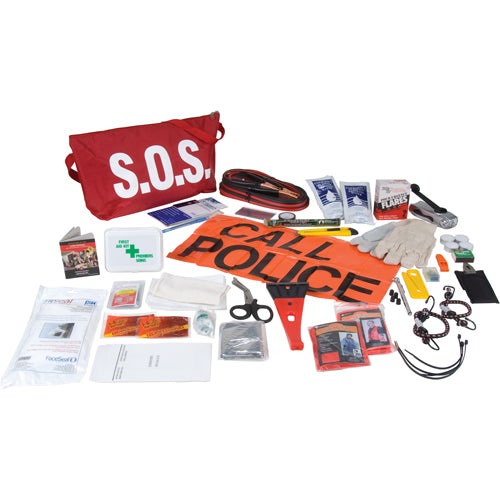When you're on the road, the last thing you want to encounter is an emergency. While you can't predict every situation, you can prepare for them. Keeping a well-stocked first aid kit in your vehicle can make a significant difference in how you respond to accidents, injuries, or other unforeseen circumstances. Here, we delve into the numerous benefits of having a First Aid Trauma Kit in your car and why every vehicle should house one.
Why You Need a First Aid Kit in Your Vehicle
Accidents can happen anywhere, at any time. Being prepared is the best way to ensure safety for you, your family, and even bystanders. Here are several reasons why a first aid kit is essential in your vehicle:
1. Immediate Response
In emergencies, time is of the essence. If someone gets injured, having a first aid kit handy allows for immediate medical attention. You can take steps to stabilize a victim or mitigate injury while awaiting professional help. A well-equipped kit makes it easier to act promptly.
2. Peace of Mind
Driving can be stressful, especially in busy areas or on long journeys. Knowing that you have a First Aid Trauma Kit in your vehicle can give you peace of mind. This reassurance is important, not just for you but also for your passengers who may feel safer with a first responder's supplies at hand.
What to Include in Your First Aid Kit
When curating your first aid kit, it's important to think about the most common injuries and situations you may encounter. Here are some essential items that should be included:
- Bandaids and Adhesive Bandages
- Gauze Pads and Adhesive Tape
- Antiseptic Wipes and Cream
- Disposable Gloves
- Scissors and Tweezers
- Pain Relief Medication
- Emergency Blanket
- Cpr Mask
- First Aid Manual
- Emergency Oxygen (if applicable)
By including these crucial components, your first aid kit will be ready to tackle various health emergencies, from minor scrapes to serious injuries.
3. Compliance and Safety Regulations
In many jurisdictions, having a first aid kit in the vehicle is not just a good idea; it's a legal requirement. Whether you drive a car, truck, or RV, ensuring compliance with local laws protects you from fines and enhances your safety on the road.
Customization: Tailoring Your First Aid Kit to Your Needs
Your first aid kit should reflect the unique needs of your lifestyle. Factors like the number of passengers, travel frequency, and individual health concerns should guide the contents of your IFAK kit.
1. Outdoor Adventures
If you're an outdoor enthusiast, your vehicle first aid kit might require additional supplies. Consider adding:
- Insect Bite and Sting Relief
- Wound Closure Strips
- Burn Cream
- QuickClot or Hemostatic dressings
2. Family Considerations
For families, you may want to include medications for children, such as:
- Pediatric Pain Relief
- Allergy Medication
- Thermometer
Customizing your first aid kit ensures you are adequately equipped for whatever situation arises.
Keeping Your Gear Bags Stocked
Once you’ve assembled your first aid kit, it’s important to maintain it. Regularly check and replenish supplies that are running low or have expired. A thorough checklist can help keep your gear bags stocked and ready for any emergency.
1. Schedule Routine Inspections
Set a schedule for routine checks—perhaps every three months. During this inspection, review supplies, replace expired items, and ensure the kit is in good condition, such as being dry and clean.
2. Involve the Family
Get your family involved in the process. Teach them about the items in the first aid kit, where it is located, and how to use key supplies. This training can empower them to act effectively in emergencies.
The Role of First Responders
Your first aid kit becomes a vital tool not just for you but also for first responders, should they arrive on the scene. It can provide them with immediate information regarding the medical situation, especially if you’re unable to share that information due to injury or shock. Having a well-structured first aid kit can serve as a primer for facilitating quicker and more effective aid.
Collaboration with First Responders
In case of an accident or emergency, always wait for professionals to handle the situation. Understand how to relay critical information. Here’s how you can help:
- Provide a brief description of the incident.
- Share the details about any first aid administered.
- Inform them about any existing medical conditions of the injured parties.
Conclusion: Ready for the Unexpected
In summary, keeping a well-stocked first aid kit in your vehicle is invaluable. From immediate response to providing peace of mind, its benefits extend far beyond basic injury management. With the right items in your First Aid Trauma Kit, regular maintenance checks, and possible customization, you'll always be prepared for emergencies. Equip yourself today to be safe tomorrow because being ready is the best way to handle the unexpected! Never let a lack of preparation put you or your loved ones at risk on the road.
Start revisiting your first aid strategy and ensure you’re ready to take on any situation should it arise. In the world of safety, every little preparation counts!



